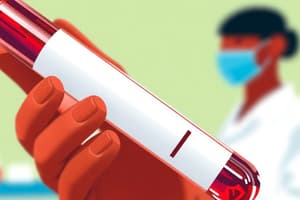Podcast
Questions and Answers
What is a common cause of sample rejection due to issues with the blood sample itself?
What is a common cause of sample rejection due to issues with the blood sample itself?
- Incorrect patient identification
- Improper labeling of tubes
- Expired collection tubes (correct)
- Insufficient volume (correct)
How does delayed results from sample rejection affect patient care?
How does delayed results from sample rejection affect patient care?
- It improves the accuracy of diagnoses.
- It leads to repeat collections. (correct)
- It increases patient satisfaction.
- It reduces healthcare costs.
Which practice is essential to prevent contamination during blood collection?
Which practice is essential to prevent contamination during blood collection?
- Drawing samples after labeling them.
- Drawing blood without a tourniquet.
- Using the correct collection tube. (correct)
- Ignoring aseptic technique.
What is a benefit of regular training for phlebotomists?
What is a benefit of regular training for phlebotomists?
What is a key laboratory protocol regarding sample handling?
What is a key laboratory protocol regarding sample handling?
What practice helps ensure proper labeling of blood samples?
What practice helps ensure proper labeling of blood samples?
What is a consequence of inaccurate testing due to sample rejection?
What is a consequence of inaccurate testing due to sample rejection?
Why is it crucial to implement quality control checks in laboratory settings?
Why is it crucial to implement quality control checks in laboratory settings?
Flashcards are hidden until you start studying
Study Notes
Causes of Rejection
- Hemolysis: Rupture of red blood cells leading to contamination of the sample.
- Clotting: Presence of clots in samples meant to be anticoagulated.
- Incorrect Tube Type: Use of the wrong collection tube, leading to additive interference.
- Insufficient Volume: Samples not meeting minimum volume requirements for testing.
- Improper Labeling: Missing or incorrect patient information on the sample label.
- Expired Tubes: Use of tubes past their expiration dates can affect sample integrity.
- Poor Collection Technique: Use of inadequate techniques leading to contamination or compromised samples.
Impact On Diagnosis
- Delayed Results: Rejection of samples leads to repeat collections, delaying patient diagnosis.
- Inaccurate Testing: Contaminated or compromised samples can result in false positives or negatives.
- Increased Costs: Recollection and retesting increase healthcare costs and resource utilization.
- Patient Dissatisfaction: Repeated blood draws can lead to discomfort and dissatisfaction among patients.
Best Practices For Collection
- Verify Patient Information: Ensure accurate patient identification before collection.
- Select Appropriate Tube: Use the correct collection tube as per test requirements.
- Follow Collection Techniques: Adhere to established protocols (e.g., clean site, use of tourniquet).
- Ensure Proper Volume: Draw adequate blood volume for the required tests.
- Label Immediately: Label samples at the bedside with date, time, and patient details.
Prevention Strategies
- Training: Regular training for phlebotomists on proper collection techniques and protocols.
- Quality Control Checks: Implement routine checks on equipment and supplies to ensure compliance.
- Standard Operating Procedures: Develop and disseminate clear procedures for blood collection and handling.
- Patient Education: Inform patients about the importance of preparation and cooperation during blood draws.
Laboratory Protocols
- Sample Handling: Ensure prompt transport of samples to the lab under appropriate conditions (temperature, light).
- Rejection Criteria: Clearly define and communicate criteria for sample rejection within the lab.
- Documentation: Maintain accurate records of rejected samples and reasons for rejection for quality assurance.
- Feedback Mechanism: Establish a process for communicating rejection reasons back to collecting personnel for improvement.
Causes of Rejection
- Hemolysis occurs when red blood cells rupture, contaminating the sample intended for testing.
- Clotting in samples designated for anticoagulation can compromise the results.
- Using the incorrect tube type can lead to interference from additives not suitable for the test.
- Insufficient sample volume can hinder the accuracy of diagnostic testing.
- Improper labeling, such as missing or incorrect patient information, can lead to misidentification of samples.
- Expired tubes may negatively impact the integrity and reliability of the samples.
- Poor collection techniques can introduce contamination or compromise sample quality.
Impact On Diagnosis
- Delayed results are common due to the need for repeat collections when samples are rejected.
- Inaccurate testing can occur with contaminated or compromised samples, leading to false positives or negatives.
- Increased costs arise from the necessity of recollection and retesting, utilizing more healthcare resources.
- Patient dissatisfaction can result from repeated blood draws, causing discomfort and frustration.
Best Practices For Collection
- Verify patient identification meticulously prior to the collection process to avoid errors.
- Select the appropriate tube based on specific test requirements to ensure compatibility.
- Follow established collection techniques, such as site cleanliness and proper use of a tourniquet.
- Ensure the blood volume collected meets the minimum requirements for accurate testing.
- Label samples immediately at the bedside, including essential details such as date, time, and patient identifiers.
Prevention Strategies
- Provide regular training for phlebotomists to enhance skills in proper collection techniques and adherence to protocols.
- Conduct quality control checks on equipment and supplies regularly to ensure compliance with standards.
- Develop and disseminate standard operating procedures for blood collection to guide personnel appropriately.
- Educate patients on the importance of preparation and cooperation during blood draws to minimize errors.
Laboratory Protocols
- Ensure samples are promptly transported to the lab under suitable conditions, maintaining the necessary temperature and light exposure.
- Define clear rejection criteria for samples and communicate these criteria within the lab to maintain quality standards.
- Document all rejected samples accurately, noting the reasons for rejection to support quality assurance efforts.
- Establish a feedback mechanism to communicate rejection reasons from the lab to collection personnel for ongoing improvement.
Studying That Suits You
Use AI to generate personalized quizzes and flashcards to suit your learning preferences.



